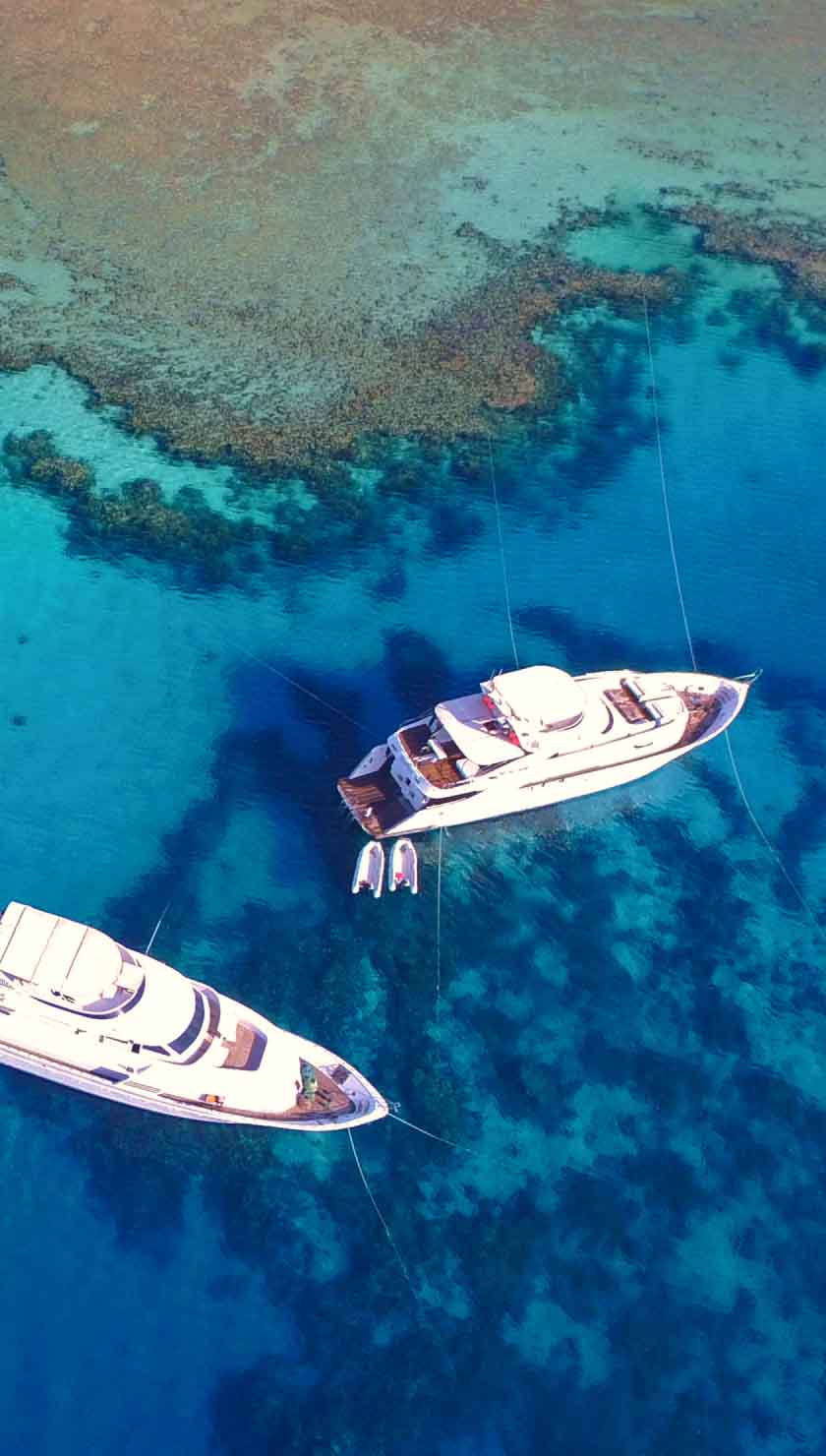Croisières plongée - Abu Nuhas
Plonger en croisière à Abu Nuhas, en Egypte
Le spot de plongée sous-marine d’Abu Nuhas n’est pas appelé le ‘cimetière des bateaux’ pour rien! Ce paradis pour amateurs de plongée épave est situé à environ 2 heures au nord d’Hurghada. Abu Nuhas, qui signifie ‘Père de la malchance,’ est un récif submergé ayant causé l’échouage d’au moins 5 bateaux, y compris l’épave la plus ancienne de la Mer Rouge, le cargo britannique Carnatic.
Les épaves d’Abu Nuhas sont idéalement explorées à bord d’un bateau de croisière. Nos yachts de safari plongée à Abu Nuhas explorent le nord de la Mer Rouge et le Sinaï au départ de Charm el-Cheikh ou d’Hurghada, incluant les meilleurs sites de plongée et épaves de la région.
Faune et flore sous-marine d’Abu Nuhas
Le point fort d’un séjour plongée à Abu Nuhas est évidemment les épaves. Ayant passé pas mal de temps sous l’eau, les épaves sont à présent colonisées par de magnifiques coraux colorés et abritent une faune marine abondante.
Sites de plongée d’Abu Nuhas
Les 4 épaves suivantes sont l’attraction principale des plongeurs à Abu Nuhas. Les voici, de la plus ancienne à la plus récente…
Le Carnatic est le favori des plongeurs en Mer Rouge. Le cargo faisait route vers l’Inde en septembre 1869 quand il s’est échoué avec sa cargaison d’or, de porto et de cuivre. Il est d’abord resté en équilibre sur le sommet du récif avant de se briser en deux et de couler à une profondeur d’environ 25 mètres. Le ravitailleur de 90 mètres de long gît sur son flanc bâbord et est en bon état. Plus de cent ans plus tard, vous pouvez plonger toute la longueur du Carnatic et admirer les barrots incrustés d’alcyonaires et d’hydroïdes, et colonisés par des nudibranches, rascasses, poissons-hachettes, poissons de verre et Platax.
Le Kimon M était un cargo transportant des lentilles de la Turquie jusqu’à Bombay quand, voyageant à plein régime, il a heurté le coin nord-est du récif d’Abu Nuhas en décembre 1978. Heureusement, le cargo ‘Interasja’ qui passait par là a immédiatement répondu aux appels de détresse et a pu secourir l’équipage et le ramener à Suez. Le Kimon M gît à présent à environ 32 m de profondeur sur son flanc tribord. Il est presque complètement intact et est un site excitant à explorer, offrant passages et traits intéressants.
Lors de son dernier voyage, en août 1981, le Chrisoula K, ou ‘l’épave du carrelage’, s’est échoué à Abu Nuhas. Ce cargo grec transportait du carrelage italien vers la ville de Djeddah quand il a heurté le coin nord-est du récif à plein régime. Heureusement, tout l’équipage a été secouru et le Chrisoula K repose à présent dans une position presque verticale sur un banc de sable dégagé. L’épave est facilement accessible aux plongeurs, à une profondeur maximale de 26 mètres et minimale de 3 mètres sous la surface. Elle est à présent incrustée de coraux durs abritant vers plats, rascasses volantes, balistes et girelles bossues, et offre des tas de passages et la possibilité de pénétrer dans la salle des machines.
Enfin, le célèbre Giannis D, un cargo transportant du bois de construction ayant coulé en 1983. Il gît à un angle de 45 degrés à 24 mètres de profondeur en eau claire, et la poupe et la proue sont toujours intactes. Les plongeurs peuvent facilement explorer les pièces et passages pour découvrir bancs de poissons de verre, rascasses, gobies, nudibranches, pieuvres et murènes géantes; sa cheminée et son célèbre ‘D’ ont souvent été photographiés.
Il y a des vestiges d’autres épaves dans la zone, ce qui n’est pas surprenant vu la position du récif d’Abu Nuhas dans le chenal de navigation, mais les 4 épaves ci-dessus sont les plus accessibles aux plongeurs loisir.
Conseils aux plongeurs
Descendez et remontez le long d’un bout si possible. Le bout vous emmène généralement au début de la plongée. Parfois, la visibilité peut être mauvaise, et faites attention au courant qui peut vous emmener dans le bleu.
Faites attention lors de la pénétration des épaves. Ecoutez bien le briefing de la plongée; le guide sait où vous pouvez et ne pouvez pas entrer pour votre propre sécurité. Certaines parties de l’épave pourraient être endommagées, ce qui peut être dangereux, et il pourrait y avoir du verre cassé, des clous ou des objets pointus.
Surveillez fréquemment votre consommation d’air et votre temps fond. C’est facile de perdre la notion du temps en plongeant sur épave, mais également de plonger à multi-niveaux pour rester dans la courbe de non-décompression; veillez à remonter quand votre ordinateur vous le signale.
Emportez un parachute de palier. En plongeant sur épave, il est possible de remonter à un endroit différent que les autres membres de votre palanquée. Un parachute permet de signaler votre position au bateau situé en surface.
Comment se rendre à Abu Nuhas
La meilleure option pour explorer Abu Nuhas est à bord d’un bateau de croisière en Mer Rouge qui démarre soit de Charm el-Cheikh, soit d’Hurghada; deux villes ayant un aéroport international et également desservies par des vols intérieurs à partir du Caire.













